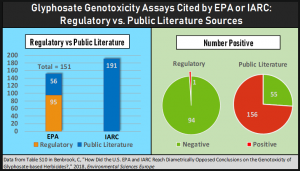Within hours on this Monday, May 13, 2019, the jury in the Pilliod Roundup-non-Hodgkin lymphoma (NHL) trial in Oakland, California is suspected to reach a verdict. It is highly likely the verdict will be the third in a row in favor of plaintiffs, following on the heels of one earlier this spring in the Hardeman trial, and the first verdict last summer in Lee Johnson’s trial.
To date, Bayer is on the hook for just under $180 million in financial awards to Hardeman and Johnson.
Another substantial award is expected in this third trial to come to closure, perhaps even exceeding $180 million, since the Oakland trial involves two people with NHL linked to their two-decades-plus use of Roundup — husband and wife Alva and Alberta Pilliod.

The size of the punitive damages awarded by the jury to the Pilliods is the $64,000 question (or maybe $64 million plus). Such awards are allowed under law to punish egregious and repeated malfeasance by companies/plaintiffs who, in the case of toxic tort cases, cook the science books, mislead regulators, and fail to place appropriate emphasis on reducing human exposures and risk.
My testimony in the Pilliod case on April 17th focused on Monsanto “stewardship,” and lack thereof, of its Roundup brand herbicides. The judge allowed me, and other plaintiff experts, to present far more new science and evidence of Monsanto misdeeds than Judge Bolanos in the Johnson trial. This is one reason a verdict in favor of the Pilliods is likely. The other big reason is the science is so clearly on the side of the plaintiffs.
Anyone sitting in the jury box in one of these Roundup-NHL trials will hear three to four weeks of testimony on 15 two-year animal bioassays, most of which show that glyphosate causes tumors.
They will learn that there are 100-plus, published genotoxicity assays showing that glyphosate or Roundup can damage DNA, enhance oxidative stress in cells, or trigger other genotoxic responses. Yet in the roughly 100 gentox assays carried out by Monsanto and submitted to EPA, only one reported a marginally positive result (for much more on glyphosate genotoxicity see our 2019 paper here).

And they will be informed that six-out-of seven peer-reviewed and published epidemiology studies report a linkage between Roundup use and exposures, and NHL, and the only one regarded as valid by Bayer/Monsanto experts is the one study that did not quite reach statistical significance.
The jury will also hear, repeatedly, from multiple Monsanto employees, scientists, and expert witnesses that there is “no evidence” that exposure to Roundup causes cancer. Period.
Credibility and truthfulness plays a big role in all contested litigation, and surely has and will continue to in forthcoming Roundup-NHL cases. The assertion by Bayer, and its attorneys and experts, that there is “no evidence” of any possible cancer risk stemming from use of Roundup has to live large in the mind of jurors as they mull over their verdict and Monsanto’s/Bayer’s behavior, before and during the trial.
On June 5, 2018, about two-months before the verdict in the Lee Johnson case, Hygeia Analytics posted a blog entitled “Bayer Announces Plans to Shed the Monsanto Name — But Will the New Bayer Differ from the Old Monsanto?” It described the importance of Bayer’s acquisition of Monsanto, and that going forward, Bayer will be largely responsible for global management of the world’s most heavily used herbicide (glyphosate) and the most heavily applied family of insecticides (neonicotinoids).
The June 2018 blog set forth a set of nine concrete actions, or “acid tests,” to track whether the “new Bayer” is destined to become the old Monsanto on steroids, or something else.
Thus far, no action has been taken on eight of the below nine “acid tests.” Just this week, Bayer has acknowledged for the first time at least a little space between its corporate culture and ethos, and Monsanto’s on the question of utilizing so-called independent, third-party voices to spread company PR.
The nine Bayer “acid tests” are reprinted below from the June 5, 2018 blog.
The Bayer Acid Test

For those working to encourage Bayer to make a clean break from the corporate behavior, marketing and stewardship policies, and ethics of Monsanto, here are nine concrete actions that the new Bayer could announce and implement in the next few months to show today’s skeptics that the new Bayer is not going to become the old Monsanto on steroids.
About half of the below steps fall safely in the no-brainer zone. The new Bayer will not need much time to reflect on their merits nor ponder how to implement them. They will either do them, or they will not, and we will know soon which it will be.
- The new Bayer will phase out globally pre-harvest, desiccation uses of Roundup and other GBHs, a huge benefit to consumers. New Bayer can do this because they will, in effect, control all GBH tolerances and most registrations allowing such uses (if you need a refresher on pesticide regulatory thresholds, see our Lowdown on Roundup Part II). If new Bayer bails on these uses, all companies will have to follow suit.
- The new Bayer will place mandatory weed resistance management provisions on all glyphosate-based herbicide labels, starting with the requirement that a GBH can be applied in no more than 2 out of 3 years on any farm field.
- The new Bayer will commit to fund independent monitoring of the spread of GLY-resistant weeds, and will pledge to quickly augment weed resistant management requirements in any region/county in which resistant weeds continue to emerge and spread. In such areas, amended labels will allow a GBH to be applied in only 1 of every 3 years on all fields.
- The new Bayer will pledge, and follow through in adding weed resistance management requirements on all 2,4-D and dicamba herbicide labels, and incorporate stringent resistance management requirements in all GE seed “Technology Use Agreements” signed annually by farmers.
- The new Bayer will cooperate with regulators worldwide (rather than bully them) to add common-sense worker protection requirements on all its pesticide labels, including over a dozen requirements that the U.S. EPA called upon Monsanto to add to dozens of glyphosate labels by 1989, but still have not been added to any Roundup label in the U.S.
- The new Bayer will: (a) stop systemic harassment of academic and other non-industry scientists wanting to conduct independent research and willing to speak openly about their findings, even when the findings are not aligned with the company’s view of reality, and (b) be fully transparent (and honest) about who, and what science they’re funding or otherwise influencing (e.g. Kevin Folta), and what seemingly independent research they are controlling in one, or several ways (e.g. Monsanto’s long and rich history of ghost-writing op-eds and peer-reviewed journal articles).
- The new Bayer will pledge to abide by any worker-safety requirements and restrictions on neonics and glyphosate imposed in the EU in ALL markets worldwide.
- The new Bayer will agree to not field test or commercialize gene editing technologies and gene drives without full assessment of the technologies by independent scientists, coupled with open, rigorous government oversight and widespread input from those impacted by, or concerned over the consequences of these emerging technologies.
- And last, the new Bayer will pledge to not field test or commercialize genetic engineering technology that renders seeds sterile, as well as any analogous technology developed to alter the DNA of animals.
The new Bayer has pledged to listen to stakeholders and its customers regarding the new paths the company will follow.
Hopefully some of the above, simple, concrete actions will make the list of reasons why the public, farmers, and governments should give the new Bayer time to prove it understands the essential goals and attributes that “modern ag” systems and technology need to embrace.

